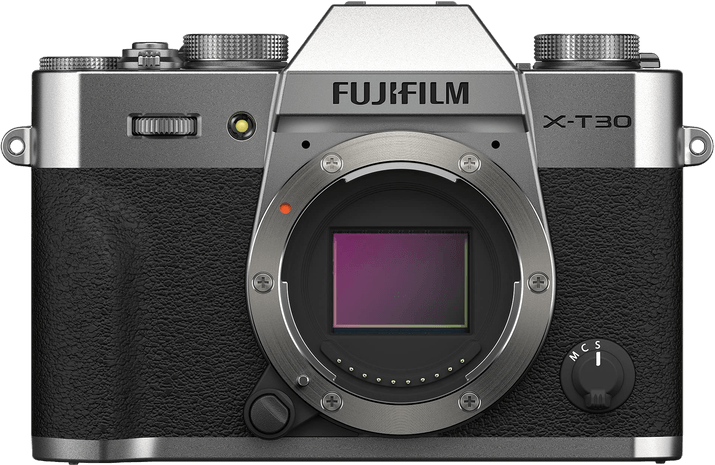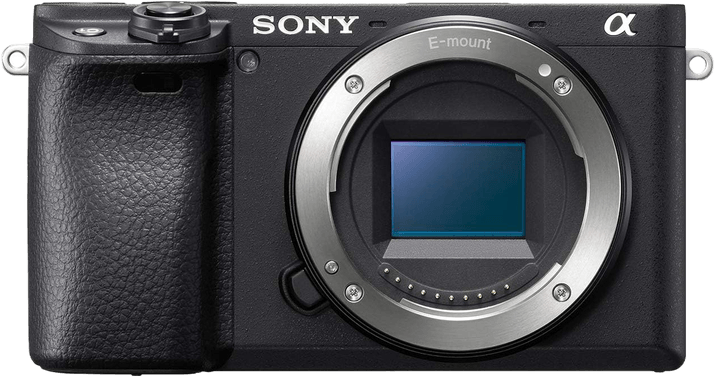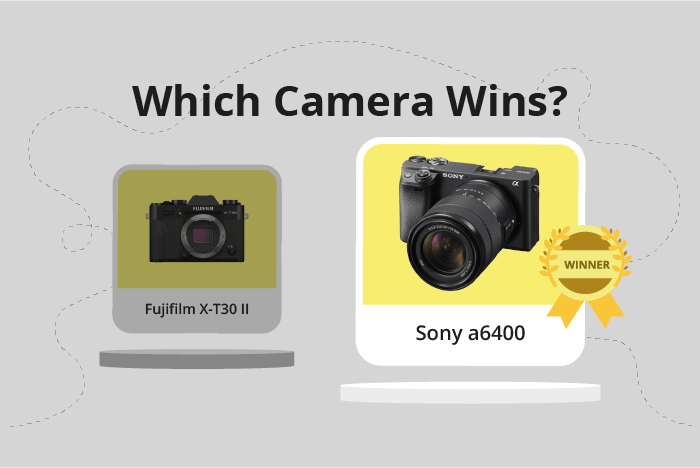Fujifilm X-T30 II vs Sony a6400 Comparison
Fujifilm X-T30 II

Sony a6400

The Sony a6400 outperforms the Fujifilm X-T30 II with a score of 70/100 versus 65/100. Both cameras are mirrorless and were released in 2019 and 2021, respectively. They share similar launch prices, with the Sony a6400 at $900 and the Fujifilm X-T30 II at $899.
The Sony a6400 excels with a more compact body, measuring 120 x 67 x 60mm, and a slightly heavier weight of 403g. This camera’s better score reflects its superior performance and features.
On the other hand, the Fujifilm X-T30 II has a larger body, measuring 118 x 83 x 47mm, but weighs less at 383g. Despite its lower score, it still offers quality performance and is a solid option for photographers.
Considering the scores and specifications, the Sony a6400 is the stronger choice for those seeking a compact and high-performing mirrorless camera. However, the Fujifilm X-T30 II remains a viable alternative for those who prioritize a lighter camera.
Fujifilm X-T30 II vs Sony a6400 Overview and Optics
The Sony a6400 edges out the Fujifilm X-T30 II in optics with a score of 68/100 compared to the Fujifilm’s 67/100. Both cameras share several specifications, including a CMOS sensor, APS-C sensor size, and no image stabilization. They also have similar lens mounts, with the Fujifilm X-T30 II using a Fujifilm X mount, while the Sony a6400 uses a Sony E mount.
The Sony a6400 has a couple of advantages over the Fujifilm X-T30 II. Firstly, it has a slightly lower megapixel count of 24.2 compared to the Fujifilm’s 26, which may result in less noise at high ISOs and better low-light performance. Secondly, the Sony a6400 has a DXOMARK score of 83 for its sensor, which is an objective measure of sensor performance. The Fujifilm X-T30 II does not have a DXOMARK score, as DXOMARK does not score Fujifilm cameras. The Sony a6400 also has a Bionz X processor, which may contribute to faster image processing and overall better performance.
On the other hand, the Fujifilm X-T30 II has a higher shooting speed of 30 frames per second, which is significantly faster than the Sony a6400’s 11 frames per second. This can be an advantage for capturing fast-moving subjects or action scenes. Additionally, the Fujifilm X-T30 II has a higher megapixel count, which can result in more detailed images.
Both cameras have their strengths and weaknesses, but the Sony a6400 has a slight edge in optics due to its DXOMARK score and potentially better low-light performance. However, the Fujifilm X-T30 II’s faster shooting speed and higher megapixel count may be more appealing to some photographers, depending on their needs.
Fujifilm X-T30 II vs Sony a6400 Video Performance
The Fujifilm X-T30 II and the Sony a6400 both excel in their video capabilities, with each camera receiving a video score of 91 out of 100. These cameras share several key specifications, including 4K video resolution, a maximum video frame rate of 120fps, and built-in time-lapse functionality. Despite the identical scores, there are some differences in their performance and features.
The Fujifilm X-T30 II has an advantage in max video dimensions, offering 4096 x 2160 pixels compared to the Sony a6400’s 3840 x 2160 pixels. This difference allows the X-T30 II to capture slightly more detailed and higher-resolution videos. This feature makes the Fujifilm X-T30 II a better choice for those seeking superior video quality.
On the other hand, the Sony a6400 stands out with its autofocus system, which is known for its speed and accuracy. While both cameras provide excellent autofocus performance, the a6400 is often praised for its reliable tracking capabilities. This feature may be beneficial for those who need to capture fast-moving subjects or maintain focus during dynamic video shoots.
Considering these differences, both cameras offer outstanding video capabilities suitable for various applications. The Fujifilm X-T30 II is the better choice for those prioritizing video resolution and detail, while the Sony a6400 excels in autofocus performance, making it ideal for fast-paced shooting situations. Ultimately, the choice between these cameras depends on the specific needs and preferences of the user.
Fujifilm X-T30 II vs Sony a6400 Features and Benefits
The Sony a6400 wins the features comparison with a score of 81/100, while the Fujifilm X-T30 II scores 70/100. Both cameras share several specifications, including a 3-inch screen size, touchscreen functionality, flip screen, GPS absence, WIFI, and Bluetooth connectivity.
The Sony a6400 outperforms the Fujifilm X-T30 II in screen resolution, offering 921,600 dots compared to the X-T30 II’s 1,040,000 dots. This higher resolution provides a sharper and clearer display, enhancing the user experience when framing shots and reviewing images.
On the other hand, the Fujifilm X-T30 II does not surpass the Sony a6400 in any specific feature. Both cameras share equal specifications in most aspects, making the X-T30 II a competitive choice, but not superior to the a6400.
Taking these factors into account, the Sony a6400 proves to be a better camera in terms of features, primarily due to its higher screen resolution. The Fujifilm X-T30 II remains a viable option for photographers who prioritize other aspects covered in the general specifications, optics, and video sections. However, for those focusing on features, the Sony a6400 is the clear winner.
Fujifilm X-T30 II vs Sony a6400 Storage and Battery
The Sony a6400 outperforms the Fujifilm X-T30 II in storage and battery with a score of 37/100 compared to the Fujifilm’s 35/100. Both cameras share similarities, having one memory card slot each and accepting SD / SDHC / SDXC (UHS-I compatible) cards. Additionally, both offer USB charging capabilities.
The Sony a6400 has an advantage in battery life, providing 410 shots compared to the Fujifilm X-T30 II’s 380 shots. The Sony camera also supports Memory Stick Duo cards, giving users more storage options. The Fujifilm X-T30 II, however, does not have any clear advantages in storage and battery over the Sony a6400.
Considering the storage and battery aspects, the Sony a6400 is a better choice for users who prioritize longer battery life and additional storage compatibility. The Fujifilm X-T30 II, while not excelling in this area, remains a competitive option with its other features and overall performance.
Fujifilm X-T30 II vs Sony a6400 – Our Verdict
Are you still undecided about which camera is right for you? Have a look at these popular comparisons that feature the Fujifilm X-T30 II or the Sony a6400:

